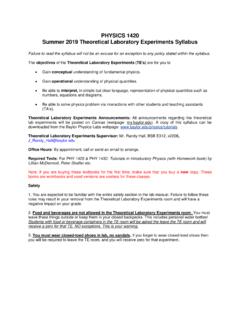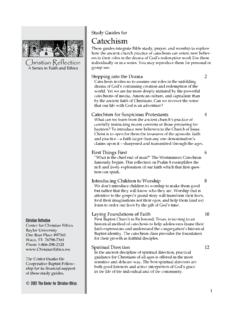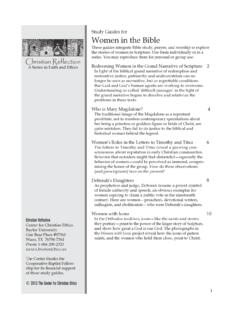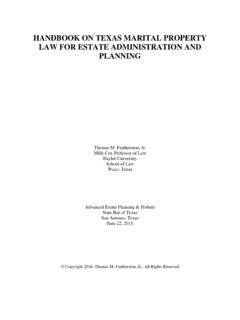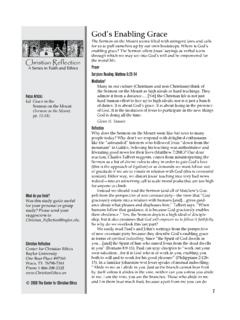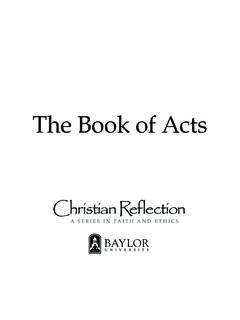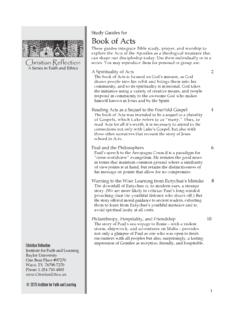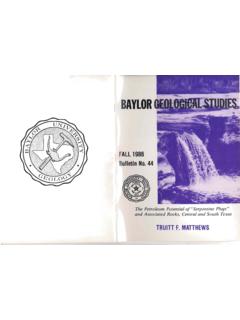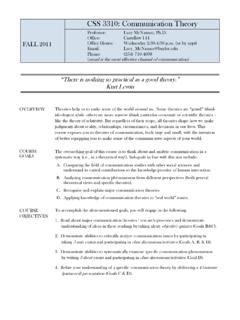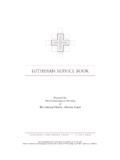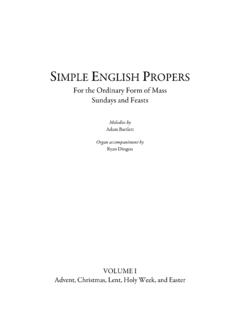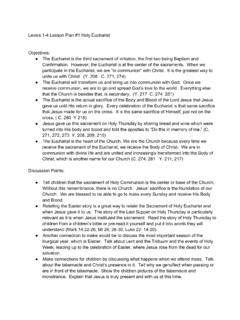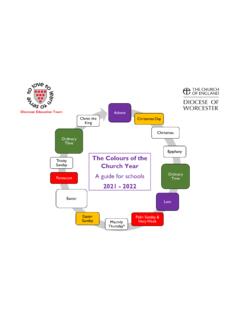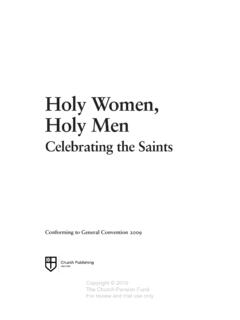Transcription of The Early History of Lent - Baylor University
1 18 2013 The Center for Christian Ethics at Baylor University The Early History of lent B y N i c h o l a s V . R u s s o The season of lent appears after the Council of Nicea. With so many biblical precedents, did it really take the Church more than 300 years to seize upon the idea of fasting for forty days? The Early History of lent is interesting and complex; it is something of a choose your own adventure.. U. ntil relatively recently, the origins of lent known as Tessarakosti in Greek and Quadragesima in Latin, for the Forty were believed to be self-evident. Many of the theology handbooks of the nineteenth and Early -twentieth century confidently claimed that lent was established by the apostles themselves or in the immediate post-apostolic period at the latest.
2 They assumed this season of fasting was closely connected with prep- aration for Easter baptisms a practice likewise considered to be of apostol- ic foundation (cf. Romans 6) and observed everywhere throughout the Church since its earliest Closer examination of the ancient sources, however, reveals a more gradual historical development. While fasting before Easter seems to have been ancient and widespread, the length of that fast varied significantly from place to place and across generations. In the latter half of the second century, for instance, Irenaeus of Lyons (in Gaul) and Tertullian (in North Africa) tell us that the preparatory fast lasted one or two days, or forty hours commemorating what was believed to be the exact duration of Christ's time in the tomb.
3 By the mid-third century, Dionysius of Alexandria speaks of a fast of up to six days practiced by the devout in his see; and the Byzantine historian Socrates relates that the Christians of Rome at some point kept a fast of three Only following the Council of Nicea in 325. did the length of lent become fixed at forty days, and then only nomi- The Early History of lent 19. nally. Accordingly, it was assumed that the forty-day lent that we encoun- ter almost everywhere by the mid-fourth century must have been the result of a gradual lengthening of the pre-Easter fast by adding days and weeks to the original one- or two-day This lengthening, in turn, was thought necessary to make up for the waning zeal of the post-apostolic church and to provide a longer period of instruction for the increasing num- bers of former pagans thronging to the font for Easter baptism.
4 Such remained the standard theory for most of the twentieth century. Y. Today, the History of lent 's origins is far less certain because many of the suppositions upon which the standard theory rested have been cast into doubt. First, scholars no longer take for granted the antiquity and ubiquity of Paschal baptism. Tertullian, admittedly, indicates that Easter was a most solemn day for baptism, but he is only one of a handful of writers in the pre-Nicene period (that is, before 325 ) who indicates this preference and even he says that Easter was by no means the only favored day for baptisms in his locale. Easter baptism does not become widespread until the mid-fourth century, and when it does, it appears to be nothing more than an idealized norm alongside which other equally acceptable occasions continue to Second, the fasts observed before baptism described in many pre-Nicene sources are no longer presumed to be pre-paschal or related in any way to lent .
5 The second-century Syrian church order known as the Didache, for exam- ple, commends the baptizer, the one to be baptized, and any others that are able to fast to prepare for the sacrament (7:4). At around the same time, Justin Martyr tells us that fasting was also enjoined on baptismal candidates in his community, and that existing members likewise prayed and fasted with them (First Apology, 61). Previously, scholars assumed these and other pre-baptismal fasts were pre-paschal and related to, if not identical, with the Early With Easter baptism no longer the ancient and widespread cus- tom once thought, these baptismal fasts too were reexamined. Rather than being part of a proto- lent , they are now interpreted simply as free-floating periods of fasting undertaken whenever baptisms were Third, developing research on holy Week and the Triduum7 has shown that these periods are not the cores of a gradually lengthening pre-Easter fast, but are actually separate periods to which the forty-day lent has been joined or overlaps.
6 We find this distinction first in Athanasius of Alexan- dria's Festal Letters sent annually to communicate, among other things, the date of Easter and its In his first five letters (329-333 ), Athanasius indicates that the holy fast spans only the six days before Pascha, perhaps revealing that lent had not yet been observed in Egypt. When he introduces the forty-day lent in his sixth letter (334 ), Athanasius continues to note the beginning of the more ancient six-day fast of the holy days of Pascha, . even though it is now part of the new six-week fast. 20 lent This distinction becomes more pronounced as the six days before Easter develop liturgically into holy Week and push lent back so that it no longer overlaps. In the Byzantine vesper (evening prayer) hymns for the Friday before holy Week, for example, when the cantor proclaims, Having complet- ed the forty days that bring profit to our soul , it is clear that lent has ended by this point.
7 On the following two days Lazarus Saturday and Palm Sunday the fasting rules are relaxed in this tra- Some have suggested that lent is best dition and a new more rigor- understood as an entirely new phenomenon ous fast is begun with holy Week (known as Great that emerges rather suddenly after Nicea and Week in the Byzantine and other Eastern traditions). We that any organic or genetic relationship it encounter the same phenom- enon in Antioch where the may have to pre-Nicene fasting practices late-fourth century church order Apostolic Constitutions cannot be proved. ( ) informs us that the more rigorous fast of the holy Week of Pascha follows the fast of the forty days and its observance is given a different rationale ( ). At around the same time John Chrysos- tom (Homilies on Genesis, ) and Egeria (Itinerarium ) also distin- guish Great Week from the rest of lent and indicate that its liturgical character changes with respect to the preceding weeks.
8 In the West, on the other hand, the distinction between lent and the Triduum is admittedly not as evident. It is now recognized that, as a liturgi- cal entity, the Triduum is a much later development than previously Accordingly, the ritual markers that would come to distinguish it from the rest of lent , the unveiling of the statues and the singing of the Gloria on Maundy Thursday emerge too late to tell us anything about the rela- tionship between the two periods earlier in History . Nonetheless, the Tridu- um as a theological concept can be seen as Early as the third century (Origen, Homilies on Exodus ) and it gains wide currency in the West with writers such as Ambrose and Augustine. Whatever the state of its liturgical devel- opment, by the fifth century Pope Leo I considers the forty days of lent to conclude with Maundy Thursday (Tractate 39), and he conceives of the Good Friday- holy Saturday fast as a separate entity.
9 It seems, therefore, that the forty days are not prolongations of the ancient Easter fasts (whether one, two, or six days long), but that they constitute a conceptually distinct unit that has been added to or overlaid on these Early fasts. These new developments in scholarship have led some to conclude that the Early History of lent is simply impossible to reconstruct. The first clear and indisputable evidence for the forty-day lent does not appear until after the Council of Nicea, and when it does, it looks to be unrelated to the earlier The Early History of lent 21. short pre-Easter fasts. As a result, some have suggested that lent is best understood as an entirely new phenomenon that emerges rather suddenly after Nicea and that any organic or genetic relationship it may have to pre- Nicene fasting practices cannot be proved.
10 Other scholars have been less willing to abandon the effort to reconstruct the pre- History of lent by focusing attention on a unique, and hotly contest- ed Egyptian fasting tradition. According to several, admittedly late sources, Christians in pre-Nicene Egypt observed a forty-day fast that began after the Feast of Theophany ( , Epiphany) on January 6 (11 Tybi on the Egyp- tian calendar). In strict imitation of the gospel narrative, this community would have commemorated the Baptism of Jesus in the Jordan on January 6. and on the following day begun a forty-day fast just as Jesus had. Some sources claim further that this community baptized its catechumens at the end of the post-Theophany fast and not at Easter. After the Council of Nicea, the theory speculates, this fast would have been moved from its original position after Theophany and joined to Easter creating the lent we know and with it bringing Egypt's baptismal practice in line with the rest of the Church.
